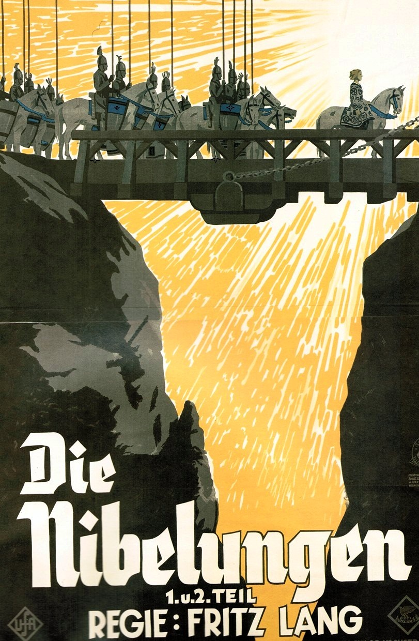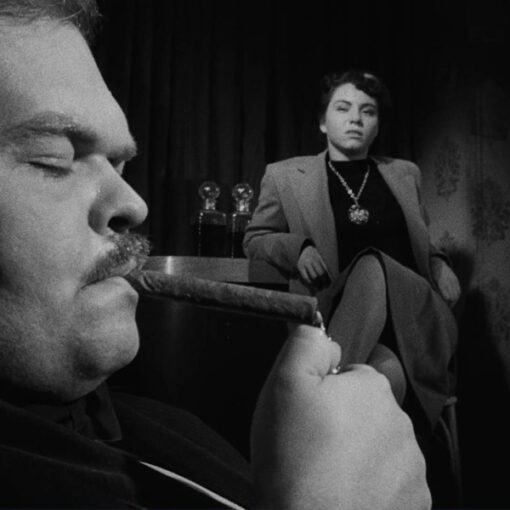 | Original title: Die Nibelungen: Siegfried and Kriemhilds Rache |
Rating:  (4.5 / 5) (4.5 / 5) | |
| Year: 1924 | |
| Director: Fritz Lang | |
| Duration: ~280 min. | |
| Genres: Drama, Fantasy |
Die Nibelungen
We all know the myth of Achilles. Of how a big, strong and handsome hero was killed by a poison arrow in his heel. But not before he did some pretty heroic stuff. Not much different is the saga of Siegfried. However, that is not all these two films are about. It tells of an epic story about ancient Germans, from the time of dragons, knights, heroic battles and items said to hold great power. Siegfried is strong, handsome and did some pretty heroic things himself. Such as slaying a dragon, looting the great treasure of Die Nibelungen and marrying the most beautiful woman of the land. And then he got killed.
The first film starts off with Siegfried crafting a new sword in the cave of Mime the blacksmith. Once done and back outside, he hears of a tale of a woman of supreme beauty, named Kriemhild. Keep in mind that this is German folklore, so the names probably all sound rather silly. Anyway, his mind is set on making her his wife. On the way to Worms, where Kriemhild lives, he slays a mighty dragon. That is, I’m sure in 1924 it was considered mighty and impressive. But that was when the computer and CGI weren’t even close to being invented.
Anyway, after he slays the dragon, a little bird – literally, a little bird – tells him to bathe in its blood to become invincible. So he does. But poor Siegfried doesn’t realise a small leaf covers a part of his back. On his way to Worms, Siegfried obtains the immense treasure of Die Nibelungen, he becomes a great king and gains quite the following. He also obtains a magic trinket called the Tarnhelm. It will make the wearer invisible, or turn him into anyone he wants. This is important, as it plays a vital part much later on. I think this is about 30 minutes in, so I’ll leave it at that. With one side note: Siegfried does not survive the first film.
He kind of is the hero, but the person this whole story revolves around isn’t Siegfried but Kriemhild. The two of them do end up getting married, but intrigue, deception and betrayal cause for Siegfrieds early demise. Siegfried’s death must be avenged by killing his killer, but Kriemhild’s brothers pledge their loyalty not to their sister, but to the killer. This triggers the second part of the epic: Kriemhild’s Revenge. It involves king Attila of the Huns, loads of people, even more people, horses, tension, fights, more betrayal, killing and an almost creepy – but thrilling – apotheosis.
Technical innovation at the time
So why should you watch this film? Well, why shouldn’t you I say. Yes it was made in 1924, yes it’s a silent film and no you probably don’t know anyone from any other films. But the story is as epic as epic gets. Fun fact, this film holds the German record for a scene with the most people in it. That’s 90 years now and it is highly unlikely it will ever be broken. The sheer amount of people on horses impresses even today’s viewers. Then there’s the dragon. While it’s true that it’s more of a giant lizard, and it doesn’t appear to be very scary, it was a technological marvel at the time. It took six strong men to move and operate it from a shaft below its belly. Compared to the dinosaurs from 1925’s The Lost World, it looks pretty damn good too. Oh, and it sets Siegfried on fire, for real it seems. How awesome is that?
The enormous size of all the sets is impressive too. The way they showed the lake of fire was just awesome. There’s a little bit of animation going on too. Just before Siegfried’s death, Kriemhild has a vision. I think I read somewhere that they used sand for the animation sequence of two black birds having a go at a white bird. Lang also used a technique to have the same person in one shot twice, when the Tarnhelm was used. There is much more, but what is really awesome is the final part of the second film. A gigantic building was set to fire using arrows with flaming tips. Lots of fighting is going on everywhere as the building slowly burns down. It is truly epic.
In the documentary Das Erbe der Nibelungen (The Heritage of the Nibelungen) they explain that the burning of the building also symbolised the end of many intense months of filming. Director Fritz Lang himself shot the first arrow, but not before the local fire department had been warned, and locals were told to expect lots of smoke that night. It took the firemen all night to extinguish the flames. In the end, the second part didn’t receive as much praise as the first, but I thought it was the better part. A little while back, the whole film was restored and released on blu-ray. Not only that, they also took parts from different copies to make it almost identical to how it was originally shot. Documentary included, Die Nibelungen is well worth the five-and-a-half hours of your time.




